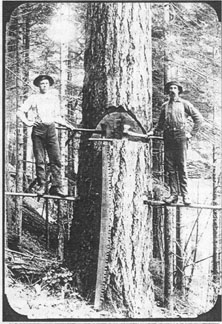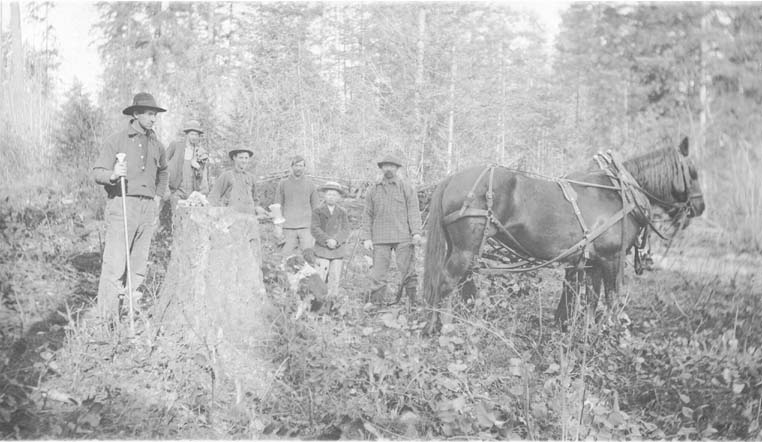
Turn-of-the-century loggers posing on
their springboards.
Canyon Life Museum
143 Wall St.
Mill City, OR
503-897-4088
Dedicated to "discover, preserve and share the history of the North Santiam Canyon", Canyon Life Museum is located in Mill City, Oregon, and is maintained by the North Santiam Historical Society.
Click here for contact information, directions and
hours, and membership information.
Visit Canyon Life Museum and find many fabulous exhibits, including
those highlighted below:
Topographic Map of North Santiam Canyon
Take a look at the map and see what the North Santiam Canyon would look like if you were flying over in it in an airplane or helicopter. The map is based on the United States Geographic Survey map and makes it easy to see how Detroit Lake fits into the hills. It shows the track of the railroad that opened the Canyon to logging. Back against the wall among the big hills is the white button number 20. That’s the southern edge of the mining district. You can see why the miners went to Gates and Lyons for supplies rather than to Detroit which is almost directly south of the mines, can’t you?
Another interesting thing the map shows is the areas that were dug out by ice age glaciers. The Mill City Glacier, as the geologists call it, flattened the area where Gates and Mill City now are, and as far west as Mehama. A smaller, later glacier scooped out the hollow where Detroit Lake is.
Something else the map lets you visualize is how difficult it was to build the Highway 22 from Gates to present-day Detroit. The railroad was being used for logging, so no trees could be cut that would fall on the track—but the hillsides are almost straight up and down. The road was considered an engineering marvel. More than one equipment operator quit in fear of his life after his machine threatened to plunge to the river.
The Hammond Mill and Springboard Logging Exhibits
Look up above the mill exhibit case to see the 45-star flag that flew in the Canyon during the ‘glory days’ of the Hammond Lumber Company sawmill and logging operations.
According to local old-timers, the Mill City Hammond Lumber Co. mill was the largest Douglas fir mill on the coast. About five other towns make the same claim for their mills, however. In any case, it was a huge mill (the exhibit text will tell you about it) and gave employment to the men of the Santiam Canyon in the woods and the mill itself.
In the exhibit case, is a picture of John A. Shaw who, with three other Stayton men, started the mill in 1886 that gave Mill City its name. The other distinguished gentleman is A. B. Hammond, owner of mills and railroads all over the west coast as well as western Montana.
As you look at the cedar stump with its springboard holes, you can imagine the loggers using a saw like the one overhead beneath the “Logging in the North Santiam Canyon” sign. The picture beside the stump shows them standing on their springboards ready for action. Springboards are leaning against the wall of the exhibit. The photo mural will give an idea of the size of the great trees of the turn of the century.
The Logging Camp Home
The logger’s wife with her baby represents all the women who lived beside the railroad tracks in the logging camps and made happy homes for their families. Her calendar, the paintings on the wall and her kitchen cabinets with their contents, all were used by people in the Santiam Canyon. Her reading material and her Bible belonged to Canyon folks and her cedar chest was made in Mill City. The little rocker came across the Oregon Trail with the grandmother of one of the first canyon families. The woodbox belonged to John Shaw. (You met him in the mill exhibit.) The bread mixer was used at Camp 26. The children’s clothing hanging beside the cupboard was worn by little boys in Mill City and Gates.
The Railroad Exhibit
The Oregon Pacific railroad, which reached Idanha before succumbing to bad management and questionable financing, made possible the North Santiam Canyon timber industry. On the trains, loggers went up the Canyon and logs came down. Many towns, logging camps and landings grew up beside the tracks. The train to and from Albany was the Canyon’s lifeline to the rest of the world. The train still comes to Frank Lumber Co. mill at the western edge of Mill City. #
The Mines and the Farms
Many people planned to ‘strike it rich’ in the North Fork mining district, but only the owners and promoters of mining stock reached that goal.
Look at the letter in the mine exhibit to get a glimpse of what life at the mines was like for the men left up in the mountains to do the hard work. (The miner’s writing is hard to read, so there is a printed “translation” of his letter right below it.)
The farm exhibit tells about some of the Canyon agriculture in flat spots—and in some not so flat. Growing food was a matter of survival. Any surplus could be sold after the women preserved and canned as much as possible. Notice the orchard records in the exhibit.
A few more highlights
Logging, farming, or working in one of the mills, small or large, provided a living for most of the Canyon folks.
Merchants in Mehama, Lyons, Mill City and Gates made their living by supplying the residents with the few necessities they could not make or grow for themselves.
A few hardy and hardworking men tried to make their fortunes in the mines on the North Fork. The descent of the miners down to the small village of Gates for the winter months resulted in some colorful events as the miners and the loggers found ways to entertain themselves during the long winter without work.
Logging camps were little villages in their own right. Close friendships arose among the families who lived in the tiny houses or in tents. When the surrounding area was logged off, the houses were loaded on railroad cars and taken to the next camp site to be used again. Camp 17 was located where the town of Detroit is today.

Logging crew, Mill City, Oregon